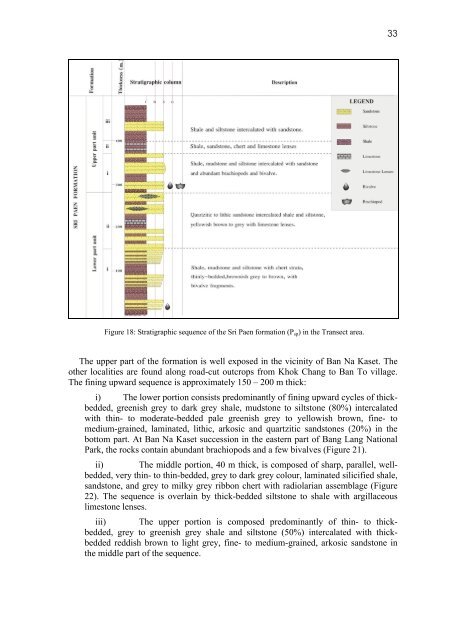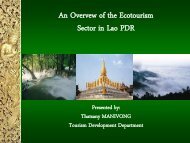GEOLOGY OF THE PENGKALAN HULU-BETONG TRANSECT ...
GEOLOGY OF THE PENGKALAN HULU-BETONG TRANSECT ...
GEOLOGY OF THE PENGKALAN HULU-BETONG TRANSECT ...
You also want an ePaper? Increase the reach of your titles
YUMPU automatically turns print PDFs into web optimized ePapers that Google loves.
Figure 18: Stratigraphic sequence of the Sri Paen formation (Psp) in the Transect area.<br />
The upper part of the formation is well exposed in the vicinity of Ban Na Kaset. The<br />
other localities are found along road-cut outcrops from Khok Chang to Ban To village.<br />
The fining upward sequence is approximately 150 – 200 m thick:<br />
i) The lower portion consists predominantly of fining upward cycles of thickbedded,<br />
greenish grey to dark grey shale, mudstone to siltstone (80%) intercalated<br />
with thin- to moderate-bedded pale greenish grey to yellowish brown, fine- to<br />
medium-grained, laminated, lithic, arkosic and quartzitic sandstones (20%) in the<br />
bottom part. At Ban Na Kaset succession in the eastern part of Bang Lang National<br />
Park, the rocks contain abundant brachiopods and a few bivalves (Figure 21).<br />
ii) The middle portion, 40 m thick, is composed of sharp, parallel, wellbedded,<br />
very thin- to thin-bedded, grey to dark grey colour, laminated silicified shale,<br />
sandstone, and grey to milky grey ribbon chert with radiolarian assemblage (Figure<br />
22). The sequence is overlain by thick-bedded siltstone to shale with argillaceous<br />
limestone lenses.<br />
iii) The upper portion is composed predominantly of thin- to thickbedded,<br />
grey to greenish grey shale and siltstone (50%) intercalated with thickbedded<br />
reddish brown to light grey, fine- to medium-grained, arkosic sandstone in<br />
the middle part of the sequence.<br />
33



